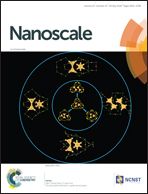Improved vaccine-induced immune responses via a ROS-triggered nanoparticle-based antigen delivery system†
Abstract
Subunit vaccines that are designed based on recombinant antigens or peptides have shown promising potential as viable substitutes for traditional vaccines due to their better safety and specificity. However, the induction of adequate in vivo immune responses with appropriate effectiveness remains a major challenge for vaccine development. More recently, the implementation of a nanoparticle-based antigen delivery system has been considered a promising approach to improve the in vivo efficacy for subunit vaccine development. Thus, we have designed and prepared a nanoparticle-based antigen delivery system composed of three-armed PLGA, which is conjugated to PEG via the peroxalate ester bond (3s-PLGA-PO-PEG) and PEI as a cationic adjuvant (PPO NPs). It is known that during a foreign pathogen attack, NADPH, an oxidase, of the host organism is activated and generates an elevated level of reactive oxygen species, hydrogen peroxide (H2O2) primarily, as a defensive mechanism. Considering the sensitivity of the peroxalate ester bond to H2O2 and the cationic property of PEI for the induction of immune responses, this 3s-PLGA-PO-PEG/PEI antigen delivery system is expected to be both ROS responsive and facilitative in antigen uptake without severe toxicity that has been reported with cationic adjuvants. Indeed, our results demonstrated excellent loading capacity and in vitro stability of the PPO NPs encapsulated with the model antigen, ovalbumin (OVA). Co-culturing of bone marrow dendritic cells with the PPO NPs also led to enhanced dendritic cell maturation, antigen uptake, enhanced lysosomal escape, antigen cross-presentation and in vitro CD8+ T cell activation. In vivo experiments using mice further revealed that the administration of the PPO nanovaccine induced robust OVA-specific antibody production, upregulation of splenic CD4+ and CD8+ T cell proportions as well as an increase in memory T cell generation. In summary, we report here a ROS-triggered nanoparticle-based antigen delivery system that could be employed to promote the in vivo efficacy of vaccine-induced immune responses.



 Please wait while we load your content...
Please wait while we load your content...